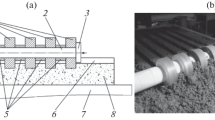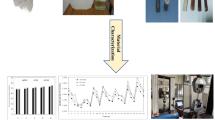Abstract
Based on experiments, wear increase directly proportional to the test duration is shown, and the wear intensity has two phases, adaptation to the abrasive environment and subsequent stabilization. Increasing the rotation speed of the holder with the samples over 800–1000 min–1 does not affect the decrease in the testing duration. We show that the increase in the speed of prototype movement contributes to the increase in the wear intensity.





Similar content being viewed by others
REFERENCES
Kablov, E.N., Composite materials: Today and tomorrow, Met. Evrazii, 2015, no. 1, pp. 36–39.
Kol’dyushov, V.K., Baurova, N.I., and Losavio, S.K., Imperfections of paint-and-lacquer coatings of polymeric composite parts, Polym. Sci., Ser. D, 2020, vol. 13, no. 1, pp. 64–67. https://doi.org/10.1134/S1995421220010104
Doriomedov, M.S., Russian and world market of polymer composites (review), Tr. VIAM, 2020, nos. 6–7, pp. 29–37. https://doi.org/10.18577/2307-6046-2020-0-67-29-37
Gladunova, O.I. and Lysenko, A.A., World and Russian market of polymer composite materials, Kompozitnyi Mir, 2021, no. 3, pp. 28–33.
Germashev, I.V., Derbisher, E.V., Evdokimov, R.A., and Derbisher, V.E., Analysis of polymer composite materials by comparing their physicochemical indicators, Izv. Volgogr. Gos. Tekh. Univ., 2022, no. 5, p. 118.
Kondrashov, S.V., Shashkeev, K.A., Petrova, G.N., and Mekalina, I.V., Constructional polymer composites with functional properties, Aviats. Mater. Tekhnol., 2017, no. 5, pp. 405–419. https://doi.org/10.18577/2071-9140-2017-0-S-405-419
Bakhareva, V.E., Nikolaev, G.I., and Anisimov, A.V., Improvement of functional properties of antifriction polymer composites for sliding friction units, Ross. Khim. Zh., 2009, vol. 53, no. 4, pp. 4–18.
Mostovoy, A.S., Vikulova, M.A., and Lopukhova, M.I., Reinforcing effects of aminosilane-functionalized h-BN on the physicochemical and mechanical behaviors of epoxy nanocomposites, Sci. Rep., 2020, vol. 10, no. 1, p. 10676. https://doi.org/10.1038/s41598-020-67759-z
Djakonov, O.M., Slimes of metal-working production, Part 1: Chemical composition, Lit’e Metall., 2010, nos. 1–2, pp. 154–159.
Nenashev, M.V., Ibatullin, I.D., Paklev, V.R., Utyankin, A.V., Polyakov, G.S., and Vasyukin, E.Yu., Tribotechnical properties of nanocomposites based on epoxy resin, Izv. Samar. Nauchn. Tsentra Ross. Akad. Nauk, 2011, vol. 13, no. 4-3, pp. 839–841.
Kolosov, O.E., Sivetskii, V.I., Sokol’skii, O.L., Ivits’kii, I.I., and Kurilenko, V.M., Materials and technologies for obtaining functional polymer composite materials, Naukovi Notatki, 2017, no. 58, p. 184.
Valueva, M.I., Evdokimov, A.A., Nacharkina, A.V., and Gubin, A.M., Polymer composite materials and technologies in the automotive industry (review), Tr. VIAM, 2022, no. 1, pp. 53–65. https://doi.org/10.18577/2307-6046-2022-0-1-53-65
Mikhal’chenkov, A.M. and Biryulina, Ya.Yu., Design for wear testing of abrasive resistant adhesive composite materials, Klei. Germetiki. Tekhnol., 2016, no. 12, pp. 40–43.
Rusin, N.M., Skorentsev, A.L., and Kolubaev, E.A., Durability of the “coating-base” composition during rolling friction, J. Frict. Wear, 2020, vol. 41, no. 3, pp. 267–272. https://doi.org/10.3103/S1068366620030083
Kuznetsov, Yu.A., Kravchenko, I.N., Sevryukov, A.A., and Glinskii, M.A., Technological methods for increasing the life of machine components, Russ. Metall. (Met.), 2019, vol. 2019, no. 13, pp. 1421–1426. https://doi.org/10.1134/S0036029519130184
Chernova, T.G., Orlik, G.V., Orlik, A.G., and Osipova, Yu.M., Deposition of coating resistant to abrasive and hydroabrasive wearing, Usp. Sovrem. Nauki, 2017, vol. 1, no. 5, pp. 162–166.
Gafner, S.L. and Nikol’skaya, A.A., Methods of testing materials and coatings for abrasive wearing and standardization, Aktual. Vopr. Nauki, 2016, no. 24, pp. 169–176.
Lokhanina, S.Yu. and Tarasov, V.V., Aspects of choosing the method for testing coating materials (strengthened layers) to wear resistance at abrasive wearing, Khim. Fiz. Mezoskopiya, 2018, vol. 20, no. 4, pp. 543–548.
Kisel’, Yu.E., Effect of structural and mechanical composites on their wear resistance, Uprochnyayushchie Tekhnol. Pokrytiya, 2011, no. 10, pp. 22–25.
Kretinin, V.I., Sokolova, V.A., Markov, V.A., Teppoev, A.V., and Alekseeva, S.V., Justification for the selection of wear-resistant coatings during hardening of tillage working bodies of forestry machines, Sist. Metody. Tekhnol., 2020, no. 2, pp. 82–86. https://doi.org/10.18324/2077-5415-2020-2-82-86
Poletaev, V.A. and Vedernikova, I.I., A study of the wear resistance of the surfaces of components via a strengthened combined electromechanical method, J. Frict. Wear, 2021, vol. 42, no. 2, pp. 112–116. https://doi.org/10.3103/S1068366621020082
Author information
Authors and Affiliations
Corresponding author
Ethics declarations
The authors declare that they have no conflicts of interest.
Additional information
Translated by I. Dikhter
About this article
Cite this article
Mikhalchenkov, A.M., Kravchenko, I.N., Fes’kov, S.A. et al. Wear of Epoxy Composites with Sludge Filler by Means of Cutting Tool Grinding under a Shock-Abrasive Impact. J. Mach. Manuf. Reliab. 51 (Suppl 1), S126–S131 (2022). https://doi.org/10.3103/S1052618822090102
Received:
Revised:
Accepted:
Published:
Issue Date:
DOI: https://doi.org/10.3103/S1052618822090102




